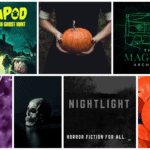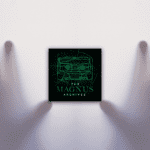A Case for the Mundane

It’s the Halloween season, a cherished time of year when fiction podcasters trot out their best ominous ambient soundscapes and scripts that usually involve a scary voice being right behind the main character. As everyone brews their apple cider and stocks up on candy for the big day, I come bearing a hot scary podcast take: embrace the mundane.
In addition to being a frontrunner for the next phrase to join “live, laugh love” and “wanderlust” in the white lady home decor lexicon, it sums up one of the most important lessons one can learn when making scary media: true fear lies in perverting the familiar. Scary things seem to always happen deep in the woods. There’s something wrong about that one old house at the end of the street. Weird sounds keep coming from that nearby abandoned school. While it’s entirely possible to create horror in any context – Jason Voorhees has been to space, after all – I argue the most effective and efficient method lies in embracing mundane, core fears. Commonplace locations sparsely populated with commonplace people who work commonplace jobs are a goldmine. Allow me to further explain by way of a busted robot shark.
Don’t show the shark
There’s a golden rule in film horror of “don’t show the monster.” One can find dozens of variations of the phrase depending on who you’re talking to or in what context it’s being talked about. My personal favorite variation is “don’t show the shark,” referencing Steven Spielberg’s happy little accidents on set that changed what kind of movie Jaws (1975) became. The movie’s about a big-ass shark terrorizing a town full of pasty white New Englanders. Loosely based off a novel (so loosely Spielberg asked star Richard Dreyfuss not to read it during casting), Jaws on paper was effectively a gore-fest American kaiju flick but with a somewhat realistically-sized shark instead of a dude in a suit stomping toy buildings. Were it made, this version of the movie would’ve been a cheesy 70s creature feature with a particularly skilled cast, director, and composer. Nothing more.
Fortunately for the moviegoing public and unfortunately for Spielberg, the shark robots built for the movie sucked. Incredibly expensive, requiring 14 people to operate, and simply inoperable for vast stretches of time during filming, the Jaws shark puppets forced Spielberg to reframe the movie around the notion that the mere suggesting the presence of the shark could be horrifying. Instead of masturbatory hero shots of the entire shark swimming underwater, he had to use implied POV (point-of-view) shots from an underwater camera to give the shark’s perspective. Fleeting glances of a dorsal fin or barrels attached to a harpoon the audience knows is embedded in the shark got people squirming in their seats.
Read more: Why Audio Is Great for Scary Stories
By not showing the shark often Jaws took full advantage of each audience member’s own personal fears in regards to open water. Simply knowing the shark existed and is near the characters is enough for the audience’s own personal fears of sharks to fill in the blanks and make it far scarier than any rubber robot could live up to. “The film went from a Japanese Saturday matinee horror flick to more of a Hitchcock, the less-you-see-the-more-you-get thriller,” said Spielberg in a 2005 Jaws retrospective for The Roanoke Times.
Jaws in script form was a horror movie in which you, the audience, are supposed to be afraid of the shark doing harm to characters. Big scary thing with lots of teeth eating people? No good, no thank you. Jaws in its finished form is a horror movie in which you, the audience, are afraid of the idea of a shark. Only having vague hints about where it is at any given time can start to play into some ancient primal fear deep in one’s guts. The same fear of the unknown one would feel when hearing something rustling just outside the light of a campfire. Moments when the shark finally kills the dead meat human in the water are actually moments of relief. A pressure is released. They’re dead, we know where the shark is, things are normal again. Thanks to Spielberg’s broken shark robots, overblown shooting schedule, and actors who disliked each other, the Jaws object of fear was shifted from a caricature of a real-world thing to a fear of having no control over one’s current situation.
Mundane versus Mars
The more basic and relatable the thing being made scary is, the easier it is for a storyteller to make it creepy. Of course, there are effective horror properties with wholly un-mundane premises. Event Horizon is effectively about a spaceship that went to hell for a few seconds and made Australian national treasure Sam Neil evil. The common thread with these more outlandish horror plots is playing to the advantages of the medium. Being a movie, things like Event Horizon or Mission to Mars can do big goofy sci-fi things and still squeeze some scares out of the proceedings with jumpscares and visual effects.
Human minds are capable of so much when left alone with a few pieces of existing information and time to put them together. HBO’s award-bait prestige drama series Chernobyl gleefully doles out horrible events with only the faintest hints of exposition at first to catch the younger viewers off-guard, even if all they have to operate on is context clues and the idea “radiation is bad.” Chernobyl remains a fascinating case study of a piece of media that, while not explicitly horror, plays to both the average viewer and a smaller second audience for whom it’s absolutely a horror show. The latter are treated to occasional seemingly-innocent lingering shots of very specific seemingly-innocent objects and places. Things people who grew up in the 80s (and history buffs) understand the significance of. The creators know you know the significance of that one hospital room full of firefighter masks, and they know it’ll creep you out.
Horror podcasts don’t have the luxury of Stan Winston-level effects or real-world events to crib from (often). There’s only so many times foley of someone squishing ground beef in their hands for gore can be used before it loses efficacy. But you, a horror producer, can easily meet an audience on an even playing field by, you guessed it, embracing the mundane.
Sure, an extra-dimensional monster or two can be scary, but so can otherwise normal background foley Hartlife NPF’s gothic horror Unwell opens with Dorothy “Dot” Harper walking home from a grocery store in, as Dot establishes with a barb of sarcasm, the quiet town of Mount Absalom. The audience is swept into a warm summer in the south, crickets chirping in the darkness as Dot’s feet crunch on a gravel road. Passing greetings from what one assumes are people in town she’s walking past begin to multiply and change, warping into something disorienting and unnerving until it reaches a fever pitch with Dot barely avoiding a passing truck. Within the first minute of the series Unwell makes explicitly clear this is not a calm, idyllic place pulled from Glen Campbell’s Southern Nights. They’ve dropped a shark in the narrative waters and you immediately lost track of it.
Generally, these kinds of op-eds are written as reactionary knee-jerk responses to trends in an industry. Given the relative balance of content in horror audio fiction over the past year or so, I’m of the opinion now is the perfect time to talk about something like this without stepping on too many toes. This piece is less motivated by a perceived glut of poorly-crafted horror and more an appreciation of those who make phenomenal horror using a particularly fascinating and efficient tool. And, to sweeten the pot beyond narrative reasons this can rock an audience’s socks off, let’s talk budget.
Less sound design can be more
Horror in audio fiction, not held down by the need for physical sets or massive server farms to produce CG environs, can easily take flight into the fantastical, the extremes. With sound design one can do anything, and frequently audio fiction does just that: anything. The trick is “anything” comes with an inherent labor and financial price tag. Even relatively simple soundscapes like Harlife NFP’s aforementioned Mount Absalom summer evening take skill and resources to craft well. The less difficult one can make the process of delivering scares on themselves, the more time can be put into making those scares effective.
Consider Paranormal Activity (2007). One of the most profitable movies ever produced, the viral found-footage hit that spawned a franchise (with woefully diminishing returns) cost just over $100,000 to produce. A guy finds out his girlfriend is haunted, rents a film-grade camera, and starts filming the house while they sleep. Unsurprisingly, things don’t turn out great for them. The majority of scares in the first Paranormal Activity are entirely from sound design and the acting chops of the microscopic cast list. In the entire film there’s maybe three shots that have any post-production visual effects magic done, one of which is literally just moving a crop to reveal footprints on the floor. Nowadays just about anyone could take the raw footage and use a copy of DaVinci Resolve 17 to do the VFX work for Paranormal Activity in a weekend.
There’s an efficacy to using mundane scenarios and locations that can distill pure fear out of something somebody sees every day. And, by virtue of being something mundane, is economically easier to replicate in a podcast. Cult classic The Evil Dead (1981), at the end of the day, is the result of a group of underpaid and overworked 20-somethings making a horror movie about an isolated cabin in the woods… while living in an isolated cabin in the woods. Albeit the result of Sam Raimi being an abusive dick to his cast and crew, there’s a brutal honesty to Evil Dead as a result of them basically making a movie about the conditions the crew was in while making the movie. A horror movie ouroboros (horrouroboros?), if you will.
Creaky floorboards, ominous air conditioner hums, flickering fluorescent lights, a second set of footsteps slightly out of sync with the character supposedly alone in a room. These things are somewhat commonplace in the real world and easy to capture on a recorder so that, in the right horrorhound’s hands, they can be deployed at just the right time to scare the pants off someone who made the mistake of listening in the middle of the night.
Audio drama that dares to try and make things we encounter in our everyday lives horrifying is a special thing and should be celebrated. Perhaps it’s a bit entry-level to discuss something as basic as “make do with what you have” mentality, a cornerstone of low-budget horror, but it feels necessary to stop and discuss why things are good on occasion. In an industry flooded with capitalist brain-worm infested corporate suits who regurgitate the same tired lies about the “low barrier to entry” producers who fought hard to get through that supposedly low barrier can achieve a hell of a lot with simple, familiar concepts.













Comments
Comments are closed.